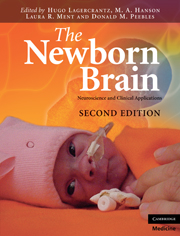Book contents
- Frontmatter
- Contents
- List of contributors
- Preface to the First Edition
- Preface to the Second Edition
- 1 Reflections on the origins of the human brain
- Section 1 Making of the brain
- 2 The molecular basis of central nervous system development
- 3 Holoprosencephaly and microcephaly vera: perturbations of proliferation
- 4 Neuronal migration
- 5 The neonatal synaptic big bang
- 6 Neurotrophic factors in brain development
- 7 Neurotransmitters and neuromodulators
- 8 Glial cell biology
- Section 2 Sensory systems and behavior
- Section 3 Radiological and neurophysiological investigations
- Section 4 Clinical aspects
- Section 5 Follow-up
- Section 6 Consciousness
- Index
- Plate section
- References
5 - The neonatal synaptic big bang
from Section 1 - Making of the brain
Published online by Cambridge University Press: 01 March 2011
- Frontmatter
- Contents
- List of contributors
- Preface to the First Edition
- Preface to the Second Edition
- 1 Reflections on the origins of the human brain
- Section 1 Making of the brain
- 2 The molecular basis of central nervous system development
- 3 Holoprosencephaly and microcephaly vera: perturbations of proliferation
- 4 Neuronal migration
- 5 The neonatal synaptic big bang
- 6 Neurotrophic factors in brain development
- 7 Neurotransmitters and neuromodulators
- 8 Glial cell biology
- Section 2 Sensory systems and behavior
- Section 3 Radiological and neurophysiological investigations
- Section 4 Clinical aspects
- Section 5 Follow-up
- Section 6 Consciousness
- Index
- Plate section
- References
Summary
Introduction
Making one synapse
Each synaptic contact is a highly complex molecular machine that extracts and integrates the numerous signals circulating among the neurons (neurotransmitters, neuromodulators, trophic factors, hormones, ions, larges families of intercellular adhesion molecules, etc.), within each neuron (the multiple and diverse cascades of intracellular signaling pathways), and along each neuron (action potentials, electrotonic depolarizations, etc.). Synapses are involved in selecting and maintaining traces of the pertinent signals required for an individual's cognitive performances. It takes 30–120 minutes to build one complete synapse between two neurons cultivated in vitro (Lohmann & Bonhoeffer, 2008). Hundreds (or thousands?) of distinct classes of molecules as diverse as cytoskeletal proteins, cell adhesion molecules, ion channels, receptors, phosphatases, phosphorylases, glycolipids, and calcium-binding proteins are assembled into multiple, highly organized scaffoldings in the presynaptic and postsynaptic compartments, and in the synaptic cleft (Samuels et al., 2007). They ensure efficient, fluctuating synaptic neurotransmission (timescale – milliseconds) and the structural stability of the mature synapse (timescale – months or years). The low affinities of these assembled proteins, as well as the mobility of the pharmacological receptors (Levi et al., 2008) also allow the molecular reorganizations associated with synaptic plasticity (timescale – seconds to weeks). These mechanisms, which ensure both stability and plasticity of the synapse, may be dependent on the high metabolic activity observed in human brain imaging.
Each synapse is a structural and functional point of articulation between the two sets of constraints presented by the genome and the environment.
- Type
- Chapter
- Information
- The Newborn BrainNeuroscience and Clinical Applications, pp. 71 - 84Publisher: Cambridge University PressPrint publication year: 2010
References
- 9
- Cited by



